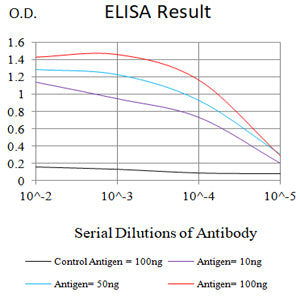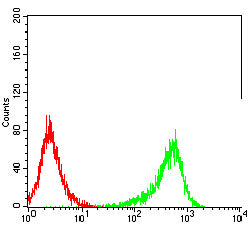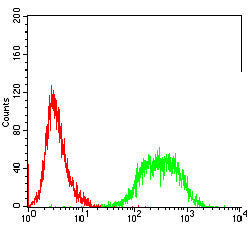




| WB | 咨询技术 | Human,Mouse,Rat |
| IF | 咨询技术 | Human,Mouse,Rat |
| IHC | 咨询技术 | Human,Mouse,Rat |
| ICC | 1/200 - 1/1000 | Human,Mouse,Rat |
| FCM | 1/200 - 1/400 | Human,Mouse,Rat |
| Elisa | 1/10000 | Human,Mouse,Rat |
| Aliases | BOB |
| Entrez GeneID | 2838 |
| clone | 2C2A8 |
| WB Predicted band size | 40.8kda |
| Host/Isotype | Mouse IgG2b |
| Antibody Type | Primary antibody |
| Storage | Store at 4°C short term. Aliquot and store at -20°C long term. Avoid freeze/thaw cycles. |
| Species Reactivity | Human |
| Immunogen | Purified recombinant fragment of human GPR15 (AA: extra mix) expressed in E. Coli. |
| Formulation | Purified antibody in PBS with 0.05% sodium azide |
+ +
以下是关于GPR15抗体的3篇参考文献及其摘要内容的简要概括:
---
1. **文献名称**: *GPR15-mediated T cell homing during colitis*
**作者**: Habtezion, A., Nguyen, L. P., Hadeiba, H., & Butcher, E. C.
**摘要**: 该研究利用抗GPR15的单克隆抗体,在小鼠结肠炎模型中证明GPR15是调节性T细胞(Treg)归巢至结肠的关键受体。阻断GPR15功能后,结肠炎症状加剧,提示其在肠道免疫稳态中的作用。
---
2. **文献名称**: *GPR15 as a coreceptor for HIV/SIV infection*
**作者**: Nguyen, K. D., et al.
**摘要**: 通过抗GPR15抗体的阻断实验,研究发现GPR15可作为HIV和SIV(猴免疫缺陷病毒)的共受体,促进病毒进入靶细胞。抗体抑制实验表明,GPR15在特定免疫细胞亚群中增强病毒感染效率。
---
3. **文献名称**: *GPR15 regulates Treg migration and immune tolerance*
**作者**: Kawaguchi, S., et al.
**摘要**: 该文献利用抗GPR15抗体分析其在调节性T细胞(Treg)中的表达及功能,发现GPR15通过介导Treg向炎症部位的迁移,参与维持免疫耐受。抗体阻断后,Treg的免疫抑制功能显著下降。
---
4. **文献名称**: *Smoking-induced GPR15 expression in leukocytes*
**作者**: Hirschi, C. S., & Mehta, A.
**摘要**: 研究通过流式细胞术结合抗GPR15抗体,揭示吸烟显著上调外周血白细胞中GPR15的表达。抗体检测技术证实GPR15可能作为吸烟相关炎症反应的生物标志物。
---
以上文献均涉及GPR15抗体的实验应用,涵盖免疫调节、病毒感染及环境因素影响等领域。
GPR15 (G protein-coupled receptor 15) is an orphan receptor belonging to the class A GPCR family, initially identified for its role in T-cell homing to the colon and skin. It gained attention due to its involvement in immune regulation and inflammation, particularly in mucosal tissues. GPR15 functions as a co-receptor for simian immunodeficiency virus (SIV) and certain HIV strains, though its role in human HIV infection remains less defined. In immunology, GPR15⁺ regulatory T cells (Tregs) are implicated in maintaining gut homeostasis and suppressing inappropriate immune responses. Dysregulation of GPR15 signaling has been associated with inflammatory bowel disease (IBD), psoriasis, and other autoimmune conditions.
Antibodies targeting GPR15 are crucial research tools for investigating receptor expression, localization, and function. They enable detection of GPR15 on immune cells via flow cytometry, immunohistochemistry, and Western blotting. Some studies explore therapeutic potential, as modulating GPR15 activity could influence T-cell migration or viral entry. However, challenges persist due to GPR15's orphan status (unknown endogenous ligand) and species-specific differences in function. Current antibody validation emphasizes specificity checks in knockout models to avoid cross-reactivity with related GPCRs. Research continues to clarify its physiological ligands and signaling pathways, positioning GPR15 antibodies as essential reagents for decoding its roles in immunity and disease.
×